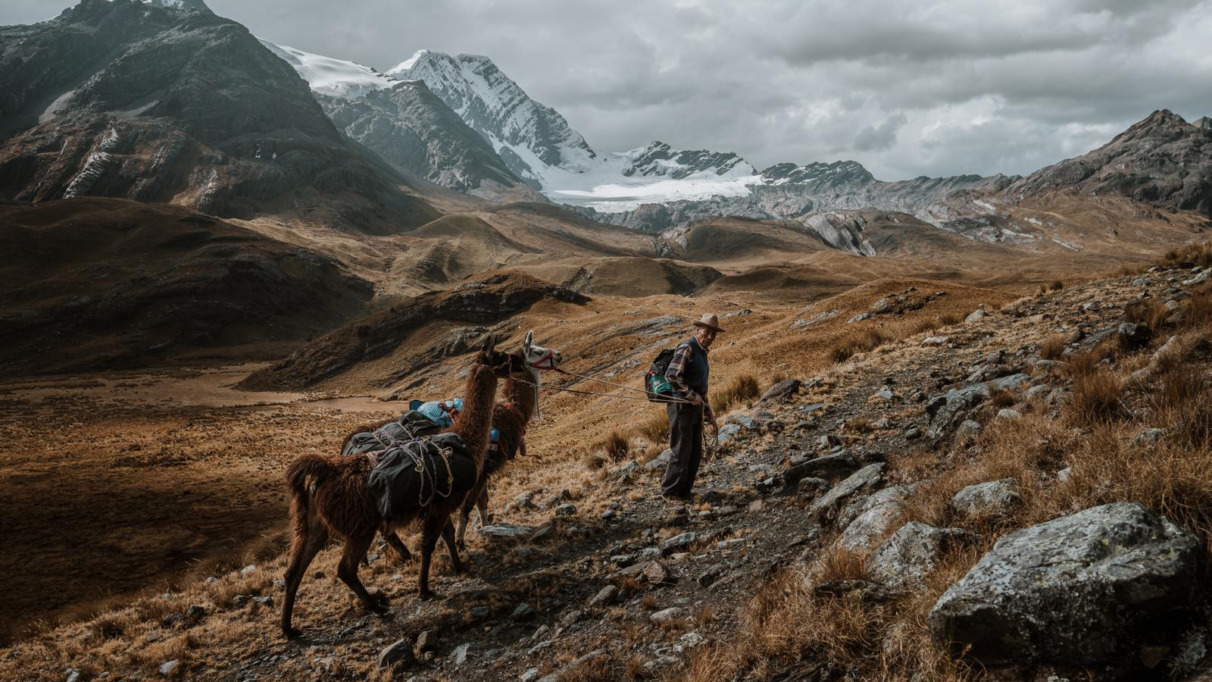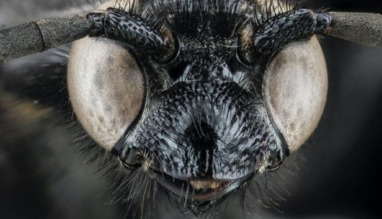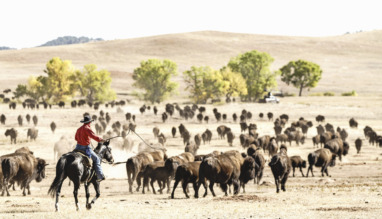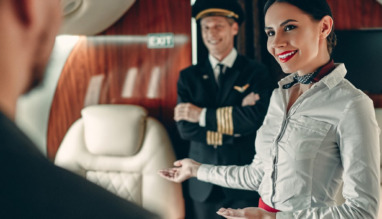Travel Story: Trekking the Sacred Andes in Peru
Turismo vivencial, or experiential tourism, goes beyond mere sightseeing—it’s about truly living the experience. With the Quechua people as our guides, we immerse ourselves in the traditions and spirit of the Peruvian Andes.
“I now pronounce you husband and wife.” The young Quechua couple concludes their wedding ceremony with an awkward hug, surrounded by a handful of family members seated on red plastic lawn chairs. Mayor Pablo Tadeo closes his civil codebook and shakes hands with those in attendance. “Listo,” he says briskly, then turns to his two foreign guests, who are watching this impromptu wedding with amused curiosity. “Are you ready to go?” We stack the chairs and bid farewell to the family, whom we’d happened to meet just thirty minutes earlier during a walk through Vicos, a mountain village of about 5,000 people in the Peruvian Andes. “I’d completely forgotten about the wedding,” Pablo admits, his face, partially hidden beneath a black wool hat, breaking into a disarming boyish grin.
Vicos is nestled within the Cordillera Blanca, the “White Mountain Range,” in northern Peru. True to its name, this range spans 112 miles and boasts over 700 glacier-covered peaks, 17 of which soar above 19,700 feet—all just south of the equator. It’s the largest snow-covered mountain range in the tropics. From Vicos, we’re treated to views of several of these snow-capped giants. But that’s not the only reason we’ve come. Vicos is one of the most authentic places in the country to experience the daily life of Andean villagers. This form of cultural exploration is known as turismo vivencial, or experiential tourism, which the residents of Vicos take quite literally. During our two-day stay, we witness joy and sorrow, life and death—a wedding, a feast, and even a funeral.
Experiential Tourism
In Vicos, the ancient Quechua culture is still vibrantly alive. Although most residents speak Spanish, Quechua is the language you’ll hear in the streets and in family homes. Daily life unfolds in traditional ways, with farming families living off the land and their animals, in harmony with Pachamama—Mother Earth—whom they honor and petition for blessings. The Quechua are often regarded as descendants of the Incas, but historians note their history extends much further back. Originating in central Peru, the Quechua people spread throughout the Inca Empire, from the Amazon to the coastal regions and from Bolivia to Colombia, giving rise to new Quechua cultures that persist to this day.
For the past two decades, the residents of Vicos have been welcoming tourists. Eight families, including our host Pablo—who is also the village’s mayor—have built guest accommodations next to their homes. Other villagers serve as guides or teach workshops in woodworking and traditional crafts. Revenue from tourism benefits the entire community. “We use donations to improve the education of our children,” says Pablo. Initially, the arrival of foreign visitors was met with skepticism. In the 16th century, Spanish conquerors ruled with an iron fist, seizing land and exploiting the native Quechua as serfs. It wasn’t until 1962 that the people of Vicos regained ownership of their land. “The elders in the village feared the gringos had returned to exploit them again,” Pablo explains over breakfast of fresh bread with honey, homemade cheese, and coffee brewed from roasted barley and fava beans. “But in time, they realized this wasn’t the case and that tourism could bring progress to the community.”
The native Quechua residents of Vicos welcome tourists into their homes.
In the kitchen below, a clay pot of fragrant soup simmers over a large wood-fired stove. A chicken clucks around the kitchen table as Pablo’s teenage children watch videos on their phones. It’s a cozy, domestic scene. “Turismo vivencial means temporarily becoming part of the family,” Pablo says. “We see our guests as family. We take care of them and place our trust in them.”
The tourism project had a slow start. “When I opened the guesthouse in 2001,” Pablo recalls, “it took a year before the first tourists came—a retired couple from the United States. I felt shy and nervous. We couldn’t understand each other or speak the same language. We called them ‘gringos, we’re going to eat,’ because we couldn’t remember their names. We spent five days together, communicating with gestures. But when it was time to say goodbye, we all cried. Later, the couple told us they’d never felt like such a part of a family before.”
Sadly, death is also an integral part of life in Vicos. The village is in mourning during our visit; Lucy, Pablo’s wife, recently lost her brother, and the funeral is taking place that afternoon. I ask Pablo how the Quechua view death. “After burying the deceased, we come together to make music, eat, and drink,” he says. “The next day, we clean and burn the clothes of the deceased to erase all traces.” It’s a radical way to process loss, but one that holds a certain beauty.
Visiting Manuel Apeña (left), a local craftsman from Vicos. Host Pablo Tadao (right) joins as well.
A Glimpse into the Andean Kitchen
Life is also celebrated here. When we wake from a chilly night under heavy woolen blankets—Vicos is over 10,000 feet above sea level, and the only source of heat is the wood fire in the kitchen—Pablo is already building a pachamanca, or “earth oven,” used to cook meat, vegetables, and potatoes on glowing hot stones buried underground. The pachamanca is more than just a meal; it’s an ancient ritual, thousands of years old, that involves and unites the entire community.
Eugenio Dexter, 59, clad in traditional black woolen pants and a matching vest, with a Spider-Man hat pulled over his head, keeps the fire burning while chewing coca leaves. Every so often, he adds a pinch of lime powder, stored in a small container around his neck, to his cheek. “It activates the coca,” Eugenio explains with a mischievous glint in his eyes. Meanwhile, the women prepare the ingredients for the pachamanca. Antolina, 65, works with a large stone mortar, crushing huacatay—a local herb with hints of basil, peppermint, and citrus—along with chili peppers and garlic. The mixture releases a bright, pungent aroma. “We use this to marinate the chicken and potatoes,” she says, glancing up from under her white wool hat adorned with blue ribbons. Beside her, Lucy washes piles of pink, yellow, and purple potatoes—all grown locally—and fava beans in their pods. Finally, the women wrap the marinated chicken in achira leaves, ready for the underground stone oven. The mouthwatering smell fills the air.
By midday, the oven is ready to be filled. First, the mounds of potatoes are buried in the pit, followed by the wrapped chicken parcels, layered with the glowing hot stones Eugenio carefully places, and finally the fava beans. The entire setup is covered with fragrant leaves, a burlap sack, and a thick layer of soil. An hour later, we sit down to eat, each with a basket full of tender chicken and potatoes. The flavors are extraordinary—smoky and soft, paired with a refreshing green salsa. We eat until we can’t anymore, as full as after a Christmas feast.
To close the celebration, we thank Mother Earth with a traditional ceremony. Eugenio passes out coca leaves, which we blow on three times while making a wish. We bury the leaves in a hole on Pablo’s land, along with pink flowers, a handful of cigarettes, and a generous splash of homemade liquor. Eugenio raises his hands to the sky and offers a prayer in Quechua. “Gracias, Taita Inti,” he says, gazing up at the brilliant Andean sun. The ritual concludes with a sip of aguardiente made from sugarcane. The fiery drink is so strong I can’t help but cough, but it’s the perfect digestif.
We part ways with the community as old friends, exchanging heartfelt hugs. I know I’ll want to return here someday.
Path to Enlightenment
In the village of Olleros, we embark on the second part of our Cordillera Blanca adventure: a three-day trek through Huascarán National Park, named after the country’s highest peak, the 22,205-foot Huascarán. The 22-mile Llama Trek starts in Olleros and ends at the temples of Chavín, following an ancient path—more than 3,000 years old—that once served as a trade and pilgrimage route connecting the coastal regions to the Andes and the Amazon. Pre-Incan civilizations used this route for commerce and cultural exchange. Like them, we travel with pack animals. Our caravan includes five llamas and one horse, carrying our gear, food, cooking supplies, and tents for the trek. Accompanying us are two kind Quechua farmers who guide the animals, along with mountain guides Jorge and Juan, the creators of the Llama Trek.
The 22-mile Llama Trek follows an a pre--Incan trail through Huascarán National Park.
The idea for the Llama Trek originated in 1996, when Jorge and Juan attended a tourism course in Huaraz. Juan had heard how Quechua people in Cusco posed with llamas to earn money. Jorge suggested a different approach: instead of posing, why not offer trekking experiences with llamas as pack animals? Traditionally, llamas have played an essential role in Andean cultures, valued for their meat, wool, and ability to carry heavy loads. The Spanish introduced cows and donkeys, sidelining the llama until its resurgence as a folkloric icon, parading through Cusco's plazas and the ruins of Machu Picchu as a tourist attraction. Jorge and Juan decided to return the llama to its original role as a pack animal for treks through the mountains they know so well. And so, the Llama Trek was born.
After six miles and about 3,300 feet of elevation gain, we see the first sign of human life since leaving Olleros. In the distance, smoke rises from a choza—a conical hut covered to the ground with ichu grass. Nearby, llamas graze peacefully. The solitary hut serves as a seasonal home for Quechua herders, who drive their cows, sheep, and llamas to higher pastures for part of the year. Yet as tranquil as the grazing llamas appear on the plateau, those in our caravan are anything but.
This is the first time Jorge and Juan have led a llama trek since the pandemic, which hit Peru disproportionately hard and brought tourism to a halt. Even the five llamas seem to need time to adjust to the return of tourists. At one point, a human-sized, woolly llama suddenly breaks loose, bounding wildly out of the caravan and charging directly at me. My heart races as I dive behind a rock, breathless from the adrenaline. It’s all part of the adventure.
Divine Mountain Guardians
About a third of the way into our route, Jorge suggests we take a lunch break. Our caravan halts in the middle of an expansive tundra, surrounded by snow-capped mountains. We collapse in the shade of a giant boulder, only to discover it’s no ordinary rock. “This is an obelisk,” Jorge says. “Travelers make offerings here to the apu principal, the highest mountain on the route. In our Quechua culture, the mountains are sacred. We see these giants as divine protectors.” Jorge kneels, removing a smaller rock to reveal a hidden chamber. Each of us is given three coca leaves, which we offer to the mountain gods, asking for safe passage on our journey.
By the end of the second day, we reach the highest point of the trek. Snowflakes drift from a leaden sky, and the thin air at 15,400 feet leaves us gasping for breath. From this mountain pass, it’s almost all downhill. We pitch our tents in a lower valley, surrounded by looming mountain ranges that look even more menacing in the twilight. In my daily life, I often find it hard to simply be in the moment, but here, it’s effortless. As clichéd as it may sound, in this remote wilderness, you can’t help but feel small and insignificant. The hardships of the trek—altitude sickness, bitterly cold nights, and days without showers or toilets—only amplify the sense of accomplishment. Moving through this majestic and powerful landscape, I finally understand why the Quechua revere these mountains as gods.
During the Llama Trek, we camp in tents.
The next morning, we begin our descent back to civilization. We pass stone-fenced fields where Quechua women in pink woolen shawls and wide skirts work the dry soil. With legs extended and backs bent, they till the earth with pickaxes. In the distance lies our destination: a temple complex built by the Chavín.
“The Chavín held great power in the region for nearly a millennium,” Jorge explains. “Their cosmology consisted of four pachas: the upper world of the sun, wind, and other elements; the world of the here and now, where humans, animals, and plants live; the underworld of death and disease; and the world of spirits. The temple complex was the religious embodiment of their power and prosperity, and the place where they worshiped the almighty Pachamama.”
An Unknown Civilization
The sense of accomplishment is immense as we reach Chavín de Huántar, perched at 10,350 feet in the foothills of the Cordillera Blanca. We made it! The complex, more than 3,000 years old, consists of two temples, plazas, and terraces, and is one of the oldest religious centers in the Andes—far older than the more famous ruins of Machu Picchu, hundreds of miles to the south. Architecturally, the Chavín were far ahead of their time. “It’s believed the Incas borrowed their building techniques, including the perfectly carved granite blocks, from the Chavín,” Jorge explains as we stand before the temple’s entrance. Behind us, at the confluence of two rivers, lies a rectangular basin. “All pilgrims were required to take a ritual bath here before entering the complex,” Jorge says. After three days without a shower, we would gladly do the same, but the basin is dry—the water level in the rivers that feed it has dropped too low after months of drought.
The over 3,000-year-old temple complex Chavín de Huántar is one of the oldest religious centers in the Andes.
Unwashed, we step into the oldest temple, a U-shaped structure with a labyrinth of underground corridors. A narrow passage leads us downward, and we immediately lose our sense of direction. We are surrounded by a nearly tangible darkness, with only the light from our phones to guide us. Carefully, we navigate the maze-like hallways, crouching under low ceilings. The damp smell of earth fills the air.
In the heart of the labyrinth, we arrive at the site where the Chavín conducted religious ceremonies. These rituals were led by shamans who entered trances induced by hallucinogenic substances such as coca leaves, cacti, and specific mushrooms. Often, these ceremonies included human sacrifices. From here, several corridors lead to a grand chamber housing a four-meter-tall (13-foot) stone monolith that represents the Chavín deity—a figure that is half-human, half-animal. Its carvings depict features of a serpent, jaguar, caiman, and a human face etched into the stone.
Under the beam of a flashlight, we see the deity’s large, round eyes gazing skyward with an enigmatic expression. In the silence of this sacred place, we reflect on our journey through the Cordillera Blanca and offer our thanks to Mother Earth for her blessings. I feel physically drained but spiritually invigorated.
Gracias, Pachamama.




